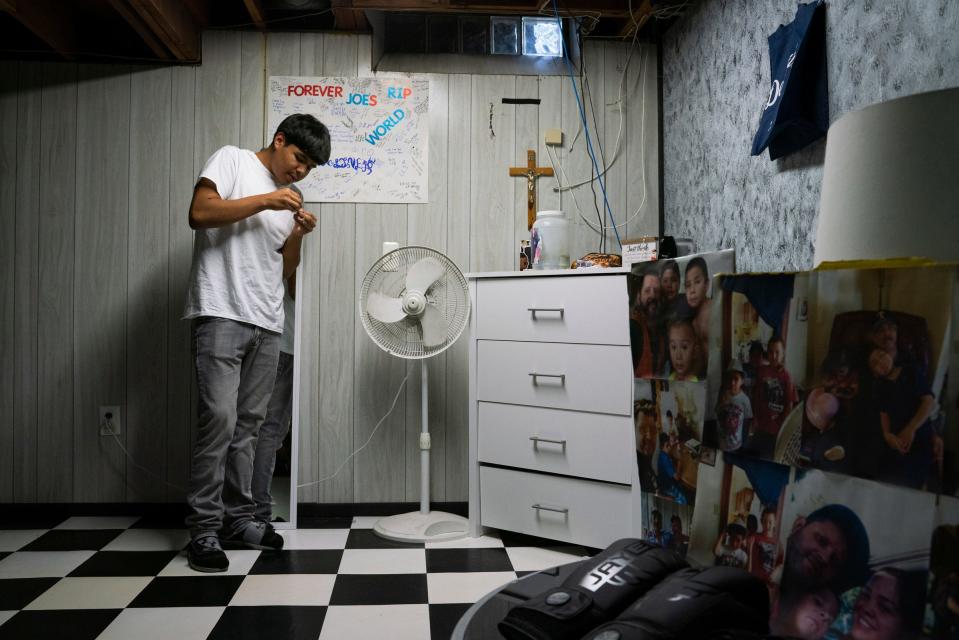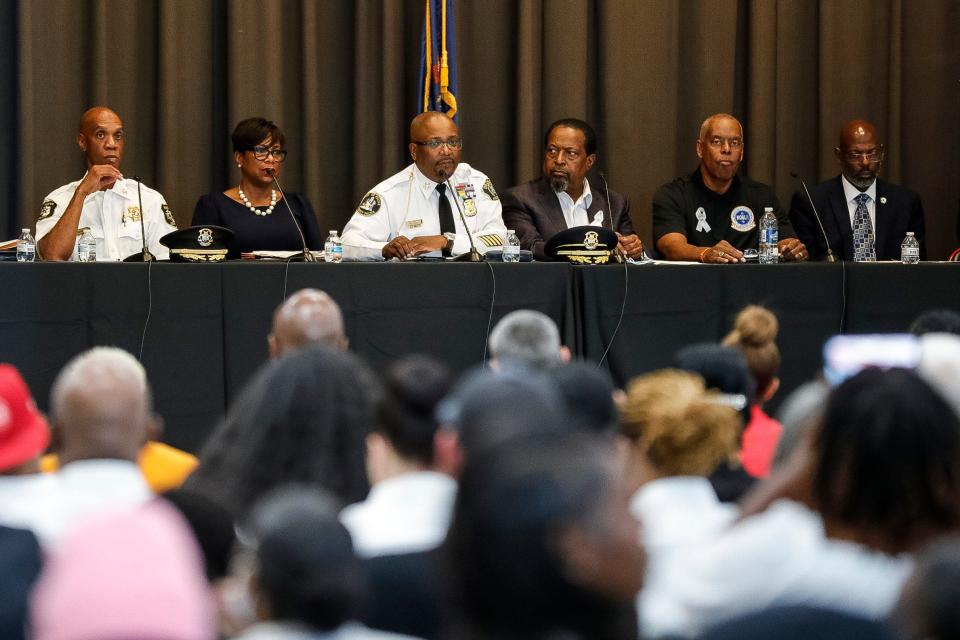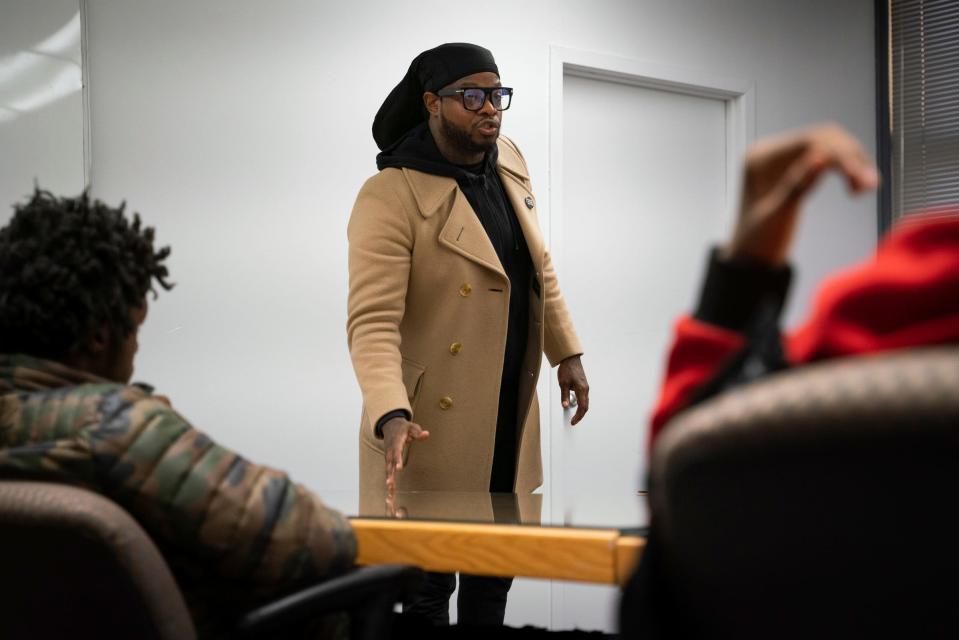Juveniles shot and killed in Detroit this year has tripled pre-pandemic numbers
The number of juveniles shot and killed in Detroit this year already has tripled the number slain in 2019, as a pandemic youth violence surge worsens and creates a nightmare for city kids, a Free Press review of police department data finds.
At least 18 kids age 17 and under were killed in shootings through mid-September fueled in part by a proliferation of guns, an increased willingness to use them, and adults’ failure to secure them, experts and those affected say. At least 65 others were wounded.
Shootings are so commonplace “you can sleep right through gunshots,” said Justin Nankervis, whose 14-year-old brother was killed in a July drive-by over a stolen cellphone. Even the benefit to raise money for his brother’s funeral was disrupted when shots rang out nearby.

“I feel like I could speak for this for everybody that lives in the ‘hood and all my friends that are still in Detroit … it’s basically normal to us,” the 16-year-old said.
The uptick is not isolated to Detroit. Statewide, juveniles have been particularly hard-hit by a pandemic-era increase in shootings. Nearly twice as many have been killed by gunfire since 2020 compared with the three years before the pandemic, while adult gun fatalities rose 28%.
In Detroit, 43 children died accidentally or intentionally from 2020 through mid-September this year, a nearly 140% rise over the prior three years. The juvenile toll far outpaces a 6% uptick in overall homicides during those same time periods. Just over 300 kids were shot overall during the pandemic, up from about 200 the previous three years.
Victims this year include:
An 8-year-old girl who was shot and killed by her 10-year-old brother with an unsecured weapon while their mother was out and the kids weren’t in school, police said. The mother has been charged with involuntary manslaughter.
Two 14-year-old girls who were shot and injured at a friend’s birthday party after a boy who felt snubbed threatened in a "group chat" to shoot it up, the father who hosted the party told the Free Press.
A 12-year-old boy who was accidentally shot and killed by a 13-year-old after police said the kids may have been “doing something with social media.” The boys had gotten ahold of two guns in the home, a neighbor who spoke with a teen who was there told the Free Press. Unbeknownst to them, one was loaded.
In a statement to the Free Press, the Detroit Police Department called the numbers “concerning” and part of an increase in gun violence nationwide.
There are “a large number of guns in our community (and) gun safety issues,” Detroit Police Chief James White told reporters at a recent public safety town hall to discuss ways to stem the violence. Adults are “not having the conversations with young people about guns and kids finding guns and making really bad decisions."
While at least a dozen accidental shootings involving younger children and unsecured weapons have captured headlines this year, the overwhelming majority of shootings of people 17 and under are intentional, police data shows. Thirteen of the 18 deadly cases this year were deliberate, giving Detroit a rate of 8.3 in every 100,000 juveniles intentionally shot dead — higher than notoriously violent-for-kids Chicago.

Justin Nankervis says he was not surprised to see the small-time theft of a cellphone end in his brother’s death. Bullets have been closing in on his family for several years.
In July 2020, across the street from Nankervis’ southwest Detroit home, a shooting killed two adults and wounded their three kids. Days after his brother Joe’s killing, a family friend’s 2-year-old daughter was shot and wounded in a drive-by. Around that time, the gunshots that cut short the benefit for Joe's funeral were followed by sirens, signaling to family the bullets had likely found a victim.
The high crime has reignited calls for solutions.
“We’ve got to do something,” Bishop Daryl Harris said at the Sept. 22 town hall. “It doesn’t need to be the same things we’ve done before … we’ve got to come up with some real stuff.”
But there’s also discord over how to proceed. Some contend the city has failed to prioritize the issue and invests too many resources reacting to crime rather than preventing it.
White “will say 'We can’t arrest our way out of this problem,' but then his budget will not say that,” Alia Harvey-Quinn, executive director of community-based violence intervention group FORCE Detroit, told the Free Press.
Damage goes deep
Justin focuses his gaze on the floor as family members recount the events that took his best friend — a “little big brother” who could sink a basketball from full court, make a room erupt with laughter and always had his back.
The July 26 killing followed Joe’s effort to retrieve his brother’s phone from a rival group that had stolen it, family said. Threats flew across Instagram for weeks until 16-year-old Ryan McLeod allegedly rolled up in a car full of teens and shot Joe as he stood in front of his house in broad daylight, police and family members say. McLeod is charged as an adult with murder.
Immediately after the shooting, Justin was “screaming hysterically, like a toddler … traumatized,” said his sister, Celena Nankervis.
He shows limited emotion now.
“Honestly … I try not to think about it,” he said.
Childhood exposure to trauma and violence has been linked to an array of lifelong consequences. Victims’ learning abilities and attention spans can worsen, causing them to lag in school, while a sense of heightened danger may increase risk factors for future violence, like gun ownership, impulsivity and aggression.
Near Joy and Southfield roads on the city's west side, about 10 miles from where Joe Nankervis was shot, kids his age face a similar reality. When a group of nine teenage boys mentored by FORCE Detroit were recently asked by a Free Press reporter how many personally knew more than one kid who’d been shot, all raised their hands.
One of the boys, a 15-year-old who did not wish to be identified for his own safety, was himself shot in the neck this spring as he watched a pickup basketball game outside Cody High School, in a shooting so commonplace it did not appear to make news.
The victim, his wound obscured by a gray hoodie drawn over his head, spoke softly as he explained how the episode left him feeling anxious.
“I don’t like being around a lot of people,” he said.
Two other boys in the group were also there that day.
“Every time I think about it, my body be feeling weird,” said one. “I used to have dreams at first. It caused me to kind of have … paranoia.”
The other said he barely escaped a bullet to the head and held the victim’s bleeding neck. He still can’t wipe the images from his mind.
“It be days where I don't want to think about it, but I still be seeing stuff,” he said.
Detroit not alone
Statewide, nearly twice as many kids — 118 — were shot and killed from 2020 through early September as were in the three years prior, according to Michigan Department of Health and Human Services death data.
In Jackson, a city of about 31,000 midway between Ann Arbor and Battle Creek, at least four people ages 17 and under were killed by gunfire in the pandemic years, versus none in the six years prior, police records and state data show.
In Ingham County, in mid-Michigan, nine juveniles have been shot and killed since 2020, compared with two in the preceding six years. Most of the shootings were in Lansing, police said, without providing specifics.
People pulling the triggers are getting younger too, said Lansing Assistant Police Chief Robert Backus. Eight juveniles were as of September held in detention for gun crimes ranging from murder to assault with intent to murder, whereas it was typical for none to be in the past, he said.
Increased access to weapons is the leading culprit, Backus said, “a trend … no different than other places in the state.”
At least one measure indicates more Michiganders are arming themselves. State-issued concealed carry permits have jumped 77% over the last eight years, with nearly 800,000 active as of September — enough to arm about one in every 13 Michiganders. Gun sales typically spike in the wake of mass shootings, unrest and uncertainty.
In cities like Detroit, greater access to guns has combined with socioeconomic problems exacerbated by the pandemic for a “toxic brew,” said Marc Zimmerman, the director of the Michigan Youth Violence Prevention Center at the University of Michigan.
“Kids don't necessarily have the best skills for dealing with conflict, especially if they haven't been in school so they haven’t learned … to control (their) emotions and not respond in violent ways,” said Zimmerman. “Add to this all of the root causes in urban centers like Detroit that have been disinvested, redlined — where there’s lots of poverty and (structural) racism.”
The boys with FORCE Detroit (Faithfully Organizing Resources for Community Empowerment) have seen firsthand the same trends as researchers and police. Guns, they said, are widely available; people bought them with pandemic relief dollars, uncles give them to nephews, kids steal them from their moms or buy illegal ones off the street. Sometimes, the boys said, kids don’t even have to buy a gun, they can just find one on the ground for free.
That, plus the amplification of conflicts on social media — where peers goad gangs and show off weapons — means that “a simple text ... can turn into you being dead,” one boy said.

Though the boys seemed aware of the risks, the day before they met with the Free Press, several fought a stranger who’d trash-talked one of their relatives.
Their mentor, Dujuan “Zoe” Kennedy, took pains during a discussion with the group to emphasize they could have died had their target been armed.
“Do y’all want to make it back home when y’all leave home?” he said to sheepish nods. “So the way you think should be built on that.”
Solutions elusive
Outside the September public safety town hall, a cluster of paper tombstones served as a somber reminder of those lost so far this year. Among the dozens of grim markers stood one for “Caleb,” age 5, who in February was shot in the head by a 16-year-old who also killed the little boy’s mom and her boyfriend, according to police. He was Caleb Harris, and one media report said he was shot nine times.
“I will never become desensitized to a child losing their lives in our city when I know there's so much more we can do," White said from a stage of judges and leaders from law enforcement, churches and elsewhere in the community.
The city’s gun-violence reduction strategy involves both punishment and prevention.
Amid the uptick in killings, police have offered to deliver gun locks to residents, added weapons detectors to major events, and spent $60 million on police overtime, in part to deploy officers to summer gathering spots where shootings might occur. Also this summer, Project Safe Neighborhoods sought to tamp down gun violence in two high-crime zones by dealing stiffer penalties to felons or criminals with guns.
Long-standing police-led deterrence efforts like Ceasefire, which aims to steer young people away from crime, have also seen more investment. Nearly $8 million in pandemic relief funds have been set aside for the program and community-based violence intervention groups similar to FORCE Detroit.
In a statement, a spokesman for Detroit Mayor Mike Duggan pointed to a reduction in the overall number of nonfatal shootings since a 2020 spike as early evidence of success.
“Major U.S. cities like Boston and New York that reduced gun violence long-term did not do it overnight,” said John Roach. “They built on sustained gains year after year, for five or 10 years, by sticking to the strategies outlined here.”
Resources are limited though and there’s disagreement over how to best deploy them. The city’s recent approval of $8.5 million for audio surveillance technology, ShotSpotter, has drawn ire from some community groups, who call it a misuse of funds that can lead to wrongful arrests.
Teferi Brent, co-founder of Dignity for Detroit, called it “reactionary,” and said more spending should go toward addressing poverty, trauma, mental health issues and educational inequities.
“If you spend $7 million on ShotSpotter, you need to spend $70 million on shot stoppers,” he said.
There is consensus, however, that the way forward requires a bold and unified approach. To that end, Darryl Woods, founder of the community group Fighting the Good Fight, floats an ambitious school-adoption plan that would enlist neighboring businesses and churches to ensure students’ basic needs are met, addressing some of the root causes that can lead to crime.
Doing more of the same, he said, is “insanity.”
Indeed, the city has been here before. Two decades ago, faced with a spike in deadly youth shootings on par with today’s, a different set of leaders proffered similar solutions in a Free Press article on the issue.
Then-Mayor Kwame Kilpatrick responded with crime-fighting initiatives that included Project Safe Neighborhoods, which, like today, dealt federal charges to criminals caught with guns. A nonprofit passed out gun locks. And Duggan, then county prosecutor, that year touted a crackdown netting more than 12 convictions involving drug rings believed responsible for a little girl's death.
But children kept dying, and by year's end, Kilpatrick gave himself a “D” grade in finding a way to end the bloodshed.
And so, today, the heightened risk persists — the latest ebb in a city long afflicted.
Joe Nankervis' family members say his friends have been getting death threats from anonymous Instagram accounts they believe his rivals run. His sister, Amber Nankervis, recently called a Free Press reporter, frantic, saying police weren’t taking them seriously.
“I don’t even know who to talk to about this,” she said. “Who do we talk to?”
Contact Violet Ikonomova: vikonomova@freepress.com.
This article originally appeared on Detroit Free Press: Rate of Detroit kids deliberately shot dead is higher than Chicago

